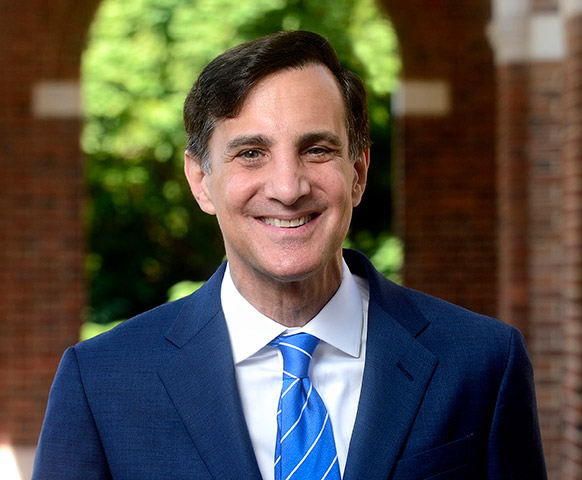
Image caption:
Ronald J. Daniels
President
You never know where you'll hear a great idea.
On a recent flight back to Baltimore, my seatmate serendipitously turned out to be a Hopkins alumna, Melanie Shimano. She was returning to Homewood to pursue her master's. We started to swap stories about what we'd been up to.
Melanie and her two best friends—fellow Johns Hopkins chemical and biomolecular engineering majors—had spent the summer refining an invention that emerged from their Senior Design class: a personal air filter with the potential to neutralize the transmission of infectious diseases on airplanes. As intriguing as their concept was their design process. She told me they had conceived of and rejected enough prototypes to fill a room before landing on one that worked. As the plane touched down, I told her I'd love to see it when they felt ready.
Without missing a beat, Melanie and her team were soon in my office, a prototype cradled carefully in her arms.
Melanie and her colleagues' enthusiasm and initiative are a microcosm of what I'm seeing across our community—that is, the desire to turn novel research into market-ready technologies and treatments. Increasingly, our faculty and students are calling for opportunities to move seamlessly along a research spectrum from basic to applied.
And Johns Hopkins is answering the call. Early next year, we will open our new innovation hub, the first of its kind located at the nexus of our East Baltimore divisions. We are also building on proof-of-concept successes, from investing in our Social Innovation Lab to support mission-driven enterprises, to expanding Homewood's FastForward business accelerator, to launching our inaugural Johns Hopkins Entrepreneurship Bootcamp, a crash course for budding inventors from more than 30 departments across Johns Hopkins Medicine.
Though these efforts respond to the needs of individual researchers, clinicians, and scientists, we also recognize the imperative of innovation for our university as a whole. At a moment when federal research funding is constrained and industry has retreated from investing in early-stage technology, we are keenly aware of the impact a robust innovation ecosystem can have on our ability to continue to achieve our mission of groundbreaking discovery, exceptional patient care, and service at home and around the globe. At the same time, we understand the powerful role that universities like Johns Hopkins can play as igniters of economic opportunity for our wider communities.
It will take our collective imagination to navigate this changing landscape and to implement our best ideas at Johns Hopkins.
Of course, as Melanie reminded me at 30,000 feet, finding creative solutions is simply what we do.

Ronald J. Daniels
President







